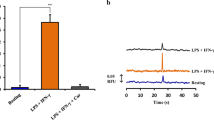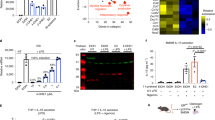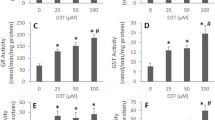Abstract
Background
Previous work has suggested that an increase in expression of cyclooxygenase-2, concomitant formation of E-type prostanoids, and in turn intracellular cAMP conveys macrophage resistance against apoptosis.
Materials and Methods
We analyzed the effects of lipophilic cAMP analogs on nitric oxide (NO)-induced apoptosis in RAW 264.7 macrophages and human primary monocyte-derived macrophages. Parameters comprised DNA fragmentation (diphenylamine assay), annexin V staining of phosphatidylserine, caspase activity (quantitated by the cleavage of a fluorogenic caspase-3-like substrate Ac-DEVD-AMC), and mitochondrial membrane depolarization (ΔΨ), analyzed using DiOC6(3). Western blots detected accumulation of the tumor suppressor protein p53, relocation of cytochrome c, and expression of the antiapoptotic protein Bcl-XL. A cAMP response-element decoy approach confirmed cAMP-dependent gene induction.
Results
We verified resistance of murine and human macrophages against NO donors such as S-nitrosoglutathione or spermine-NO by pre-exposing cells to lipophilic cAMP analogs or by pretreatment with lipopolysaccaride, interferon-γ, and NG-nitroarginine-methylester for 15 hr. Cellular prestimulation decreased NO-evoked apoptosis, as apoptotic parameters were basically absent. Macrophage protection was not achieved during a short period of preexposure, i.e., 1 hr. To verify gene induction as the underlying protective principle, we treated RAW cells with oligonucleotides containing a cAMP-responsive element in order to scavenge cAMP response element-binding protein prior to its promoter-activating ability. Decoy oligonucleotides, but not an unrelated control oligonucleotide, weakened cAMP-evoked protection and re-established a p53 response following NO addition.
Conclusion
Gene induction by cAMP protects macrophages against apoptosis that occurs as a result of excessive NO formation. Decreasing programmed cell death of macrophages may perpetuate inflammatory conditions in humans when macrophages become activated in close association with innate immune responses.






Similar content being viewed by others
References
Smith WL, Marnett LJ. (1991) Prostaglandin endoperoxide synthase: structure and catalysis. Biochim. Biophys. Acta 1083: 1–17.
Smith WL, Garavito RM, DeWitt DL. (1996) Prostaglandin endoperoxide H synthases (cyclooxygenases)-1 and -2. J. Biol. Chem. 271: 33157–33160.
Coleman RA, Smith WL, Narumiya S. (1994) International Union of Pharmacology classification of prostanoid receptors: properties, distribution, and structure of the receptors and their subtypes. Pharmacol Rev. 46: 205–229.
Herschman HR, Reddy ST, Xie W. (1997) Function and regulation of prostaglandin synthase-2. Adv. Exp. Med. Biol. 407: 61–66.
Hempel SL, Monick MM, He B, Yano T, Hunninghake GW. (1994) Synthesis of prostaglandin H synthase-2 by human alveolar macrophages in response to lipopolysaccharide is inhibited by decreased cell oxidant tone. J. Biol. Chem. 269: 32979–32984.
Lee SH, Soyoola E, Chanmugam P, et al. (1992) Selective expression of mitogen-inducible cyclooxygenase in macrophages stimulated with lipopolysaccharide. J. Biol. Chem. 267: 25934–25938.
O’Sullivan MG, Huggins EMI, Meade EA, DeWitt DL, McCall CE. (1992) Lipopolysaccharide induces prostaglandin H synthase-2 in alveolar macrophages. Biochem. Biophys. Res. Commun. 187: 1123–1127.
Brüne B, Gölkel C, von Knethen A. (1996) Cytokine and low-level nitric oxide prestimulation block p53 accumulation and apoptosis of RAW 264.7 macrophages. Biochem. Biophys. Res. Commun. 229: 396–401.
von Knethen A, Brüne B. (1997) Cyclooxygenase-2: an essential regulator of NO-mediated apoptosis. FASEB J. 11: 887–895.
Giovannucci E, Egan KM, Hunter DJ, et al. (1995) Aspirin and the risk of colorectal cancer in women. N. Engl J. Med. 333: 609–614.
Reddy BS, Maruyama H, Kelloff G. (1987) Dose-related inhibition of colon carcinogenesis by dietary piroxicam, a nonsteroidal antiinflammatory drug, during different stages of rat colon tumor development. Cancer Res. 47: 5340–5346.
Oshima M, Dinchuk JE, Kargman SL, et al. (1996) Suppression of intestinal polyposis in Ape delta716 knockout mice by inhibition of cyclooxy-genase 2 (COX-2). Cell 87: 803–809.
Prescott SM, White RL. (1996) Self-promotion? Intimate connections between APC and prostaglandin H synthase-2. Cell 87: 783–786.
Tsujii M, Kawano S, DuBois RN. (1997) Cyclooxygenase-2 expression in human colon cancer cells increases metastatic potential. Proc. Natl. Acad. Sci. U.S.A. 94: 3336–3340.
Sheng H, Shao J, Kirkland SC, et al. (1997) Inhibition of human colon cancer cell growth by selective inhibition of cyclooxygenase-2. J. Clin. Invest. 99: 2254–2259.
Tsujii M, DuBois RN. (1995) Alterations in cellular adhesion and apoptosis in epithelial cells over expressing prostaglandin endoperoxide synthase 2. Cell 83: 493–501.
Zhang DE, Hetherington CJ, Gonzalez DA, Chen HM, Tenen DG. (1994) Regulation of CD14 expression during monocytic differentiation induced with 1 alpha,25-dihydroxyvitamin D3. J. Immunol 153: 3276–3284.
Landmann R, Ludwig C, Obrist R, Obrecht JP. (1991) Effect of cytokines and lipopolysaccharide on CD 14 antigen expression in human monocytes and macrophages. J. Cell Biochem. 47: 317–329.
Gantner F, Kupferschmidt R, Schudt C, Wendel A, Hatzelmann A. (1997) In vitro differentiation of human monocytes to macrophages: change of PDE profile and its relationship to suppression of tumour necrosis factor-alpha release by PDE inhibitors. Br. J. Pharmacol 121: 221–231.
Krause S, Kreutz M, Andreesen R. (1999) Isolation, characterization and cultivation of human monocytes and macrophages. In: Kaufmann S, Kabelitz D (eds). Methods in Microbiology—Immunology of Infection. Academic Press, San Diego, pp. 663–684.
McConkey DJ, Nicotera P, Hartzell P, Bellomo G, Wyllie AH, Orrenius S. (1989) Glucorticoids activate a suicide process in thymocytes through an elevation of cytosolic Ca2+ concentration. Arch. Biochem. Biophys. 269: 365–370.
Burton K. (1956) A study of the conditions and mechansim of the diphenylamine reaction for the estimation of deoxyribonucleic acid. Biochem. J. 62: 315–323.
Koopman G, Reutelingsperger CP, Kuijten GA, Keehnen RM, Pals ST, van Oers MH. (1994) Annexin V for flow cytometric detection of phosphatidylserine expression on B cells undergoing apoptosis. Blood 1415–1420.
Martin SJ, Reutelingsperger CP, McGahon AJ, et al. (1995) Early redistribution of plasma membrane phosphatidylserine is a general feature of apoptosis regardless of the initiating stimulus: inhibition by overexpression of Bcl-2 and Abl. J. Exp. Med. 182: 1545–1556.
Hart TW. (1985) Some observations concerning the S-nitroso and S-phenylsulphonyl derivates of L-cysteine and glutathione. Tetrahedron Lett. 26: 2013–2016.
Leist M, Volbracht C, Fava E, Nicotera P. (1998) 1-Methyl-4-phenylpyridinium induces autocrine excitotoxicity, protease activation, and neuronal apoptosis. Mol Pharmacol 54: 789–801.
Petit PX, O’Connor JE, Grunwald D, Brown SC. (1990) Analysis of the membrane potential of rat-and mouse-liver mitochondria by flow cytometry and possible applications. Eur. J. Biochem. 194: 389–397.
Sassone-Corsi P, Visvader J, Ferland L, Mellon PL, Verma IM. (1988) Induction of proto-oncogene fos transcription through the adenylate cyclase pathway: characterization of a cAMP-responsive element. Genes Dev. 2: 1529–1538.
Lowry OH, Rosebrough NJ, Farr AL, Randall RJ. (1951) Protein measurement with the Folin phenol reagent. J. Biol. Chem. 193: 265–275.
Laemmli UK. (1970) Cleavage of structural proteins during assembly of the heard of bacteriophage T4. Nature 227: 680–685.
Messmer UK, Brüne B. (1996) Nitric oxide (NO) in apoptotic versus necrotic RAW 264.7 macrophage cell death: the role of NO-donor exposure, NAD + content, and p53 accumulation. Arch. Biochem. Biophys. 327: 1–10.
Stamler JS. (1994) Redox signaling: nitrosylation and related target interactions of nitric oxide. Cell 78: 931–936.
von Knethen A, Lotero A, Brüne B. (1998) Etoposide and cisplatin induced apoptosis in activated RAW 264.7 macrophages is attenuated by cAMP-induced gene expression. Oncogene 17: 387–394.
Messmer UK, Ankarcrona M, Nicotera P, Brüne B. (1994) p53 expression in nitric oxide-induced apoptosis. FEBS Lett. 355: 23–26.
Okada S, Zhang H, Hatano M, Tokuhisa T. (1998) A physiologic role of Bcl-xL induced in activated macrophages. J. Immunol. 160: 2590–2596.
Brockhaus F, Brüne B. (1998) U937 apoptotic cell death by nitric oxide: Bcl-2 downregulation and caspase activation. Exp. Cell Res. 238: 33–41.
Callsen D, Brüne B. (1999) The role of mitogen-activated protein kinases in 5-nitrosoglutathione-induced macrophage apoptosis. Biochemistry 38: 2879–2886.
Green DR. (1998) Apoptotic pathways: the roads to ruin. Cell 94: 695–698.
Messmer UK, Brüne B. (1996) Nitric-oxide induced apoptosis: p53-dependent and p53-independent signalling pathways. Biochem. J. 319: 299–305.
Levy GN. (1997) Prostaglandin H synthases, nonsteroidal antiinflammatory drugs, and colon cancer. FASEB J. 11: 234–247.
Quinn MR, Park E, Schuller-Levis G. (1996) Taurine chloramine inhibits prostaglndin E2 production in activated RAW264.7 cells by post-transcriptional effects on inducible cyclooxygenase expression. Immunol Lett. 50: 185–188.
Zhang F, Warskulat U, Wettstein M, et al. (1995) Hyperosmolarity stimulates prostaglandin synthesis and cyclooxygenase-2 expression in activated rat liver macrophages. Biochem. J. 312: 135–143.
Vial D, Arbibe L, Havet N, Dumarey C, Vargaftig B, Touqui L. (1998) Down-regulation by prostaglandins of type-II phospholipase A2 expression in guinea-pig alveolar macrophages: a possible involvement of cAMP. Biochem. J. 330: 89–94.
Kawase T, Orikasa M, Suzuki A. (1992) Phorbol ester-like action of staurosporine on the cAMP response to prostaglandin E2 in two macrophage-like cell lines at distinct differentiation stages. Cell Signal 4: 479–485.
Walker BA, Rocchini C, Boone RH, Ip S, Jacobson MA. (1997) Adenosine A2a receptor activation delays apoptosis in human neutrophils. J. Immunol 158: 2926–2931.
Fladmark KE, Gjertsen BT, Doskeland SO, Vintermyr OK. (1997) Fas/APO-1 (CD95)-induced apoptosis of primary hepatocytes is inhibited by cAMP. Biochem. Biophys. Res. Commun. 232: 20–25.
Torgersen KM, Vaage JT, Levy FO, Hansson V, Rolstad B, Tasken K. (1997) Selective activation of cAMP-dependent protein kinase type I inhibits rat natural killer cell cytotoxicity. J. Biol. Chem. 272: 5495–5500.
Houslay MD, Milligan G. (1997) Tailoring cAMP-signalling responses through isoform multiplicity. Trends Biochem. Sci. 22: 217–224.
Frank DA, Greenberg ME. (1994) CREB: a mediator of long-term memory from mollusks to mammals. Cell 79: 5–8.
Nakajima T, Uchida C, Anderson SF, Parvin JD, Montminy M. (1997) Analysis of a cAMP-responsive activator reveals a two-component mechanism for transcriptional induction via signal-dependent factors. Genes Dev. 11: 738–747.
Kwok RPS, Lundblad JR, Chrivia JC, et al. (1994) Nuclear protein CBP is a coactivator for the transcription factor CREB. Nature 370: 223–226.
Arias J, Alberts AS, Brindle P, et al. (1994) Activation of cAMP and mitogen responsive genes relies on a common nuclear factor. Nature 370: 226–229.
Tortora G, Caputo R, Damiano V, et al. (1997) Synergistic inhibition of human cancer cell growth by cytotoxic drugs and mixed backbone antisense oligonucleotide targeting protein kinase A. Proc. Natl. Acad. Sci. U.S.A. 94: 12586–12591.
Tortora G, di Isernia G, Sandomenico C, et al. (1997) Synergistic inhibition of growth and induction of apoptosis by 8-chloro-cAMP and paclitaxel or cisplatin in human cancer cells. Cancer Res. 57: 5107–5111.
Yang YM, Dolan LR, Ronai Z. (1996) Expression of dominant negative CREB reduces resistance to radiation of human melanoma cells. Oncogene 12: 2223–2233.
Ruchaud S, Seite P, Foulkes NS, Sassone-Corsi P, Lanotte M. (1997) The transcriptional repressor ICER and cAMP-induced programmed cell death. Oncogene 15: 827–836.
Ivanov VN, Lee RK, Podack ER, Malek TR. (1997) Regulation of Fas-dependent activation-induced T cell apoptosis by cAMP signaling: a potential role for transcription factor NF-kappa B. Oncogene 14: 2455–2464.
Acknowledgments
We thank Sabine Häckel for expert technical assistance. This work was supported by grants from the Deutsche Forschungsgemeinschaft and Deutsche Krebshilfe.
Author information
Authors and Affiliations
Corresponding author
Rights and permissions
About this article
Cite this article
von Knethen, A., Brockhaus, F., Kleiter, I. et al. NO-Evoked Macrophage Apoptosis Is Attenuated by cAMP-Induced Gene Expression. Mol Med 5, 672–684 (1999). https://doi.org/10.1007/BF03401986
Accepted:
Published:
Issue Date:
DOI: https://doi.org/10.1007/BF03401986




